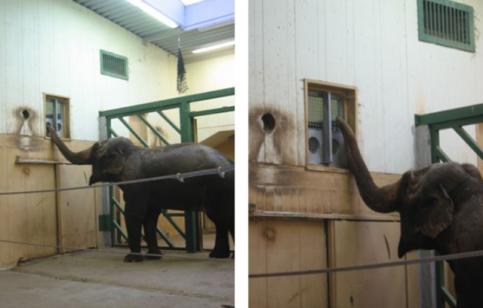Material & Methods
The behavioral test and the experimental set-up
The study was conducted using three adult female Asian elephants (Elephas maximus) housed at Kolmården Wildlife Park. Saonoi and Bua were born 1996 and 1997, respectively in Thailand at work camps and have been housed at the Swedish zoo since 2004. Saba (born 1968) was transferred to Kolmården Wildlife Park from Zoo Le Pal, France, at the end of 2007.
The method used in these experiments are based on a food-rewarded two-alternative operant conditioning procedure. The animals learned to sniff at two odor ports and were food-rewarded when they performed an operant response (placing the tip of the trunk at a certain position of the experimental set-up) upon correctly identifying the rewarded odor. Only positive reinforcement was used and the elephants participation was voluntary.

A total of three experiments were conducted.
Experiment 1 was conducted to assess the ability of the animals to discriminate between aliphatic odorants that are structurally related to each other (only differ in carbon chain length).
Experiment 2 was conducted to assess the ability of the animals to discriminate between enantiomeric odor pairs which are structurally identical but are mirror images of each other.
Finally, Experiment 3 was conducted to evaluate the long-term odor memory of the animals for a given odor combination after a recess in training for three weeks and one year.
In the method described here, the animal had two options: (1) to correctly respond to the positive stimulus (correct decison), and (2) to falsely respond to the negative stimulus (incorrect decision). The percentage of correct decisions was used as the measure of performance.
In all tasks, the criterion of individual performance was set at either 70% hits in one session of 30 decisions (corresponding to p < 0.05, two-tailed binomial test), or at 80% hits in one session (corresponding to p < 0.01, two-tailed binomial test). The rationale for choosing these criteria is that the same criteria have been used in previous studies on olfactory learning and discrimination performance with other species that data is being compared to. First session was used when analyzing only one session and first and second session was used when analyzing the combined sessions.
Responsible for this page:
Director of undergraduate studies Biology
Last updated:
05/08/12
